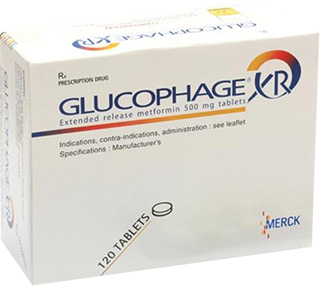Medication Overview: Glucophage
Glucophage contains the active ingredient metformin. It is classified as a biguanide antidiabetic medication. This medication is designed primarily for adult and pediatric patients with type 2 diabetes mellitus. It helps to enhance glycemic control in conjunction with diet and exercise. Glucophage is available in various formulations, including regular, extended-release, and oral solution.
Mechanism of Action
Glucophage lowers blood glucose levels through several pathways. It decreases hepatic glucose production and intestinal glucose absorption. Furthermore, it enhances insulin sensitivity by increasing peripheral glucose uptake and utilization, which results in improved glucose tolerance. Glucophage does not stimulate insulin secretion, thus minimizing the risk of hypoglycemia when used as monotherapy.
Standard Dosage Instructions
The initial adult dose usually starts at 500 mg once or twice daily or 850 mg once daily. Dose adjustments are made based on glycemic response. Maximum doses typically do not exceed 2500 to 2550 mg per day. For pediatric patients aged 10 and above, the starting dose is generally 500 mg twice daily. Dose titration should follow careful evaluation of safety and efficacy.
Special Population Considerations
Elderly Patients
Elderly patients may require adjusted dosing due to potential renal impairment. Kidney function monitoring is crucial before and during treatment. Initiate therapy with caution, considering the patient’s overall health status and presence of concomitant conditions. Dose escalation should be carefully monitored to prevent adverse renal impacts.
Renal Impairment Categories
In patients with mild renal impairment, dosage adjustment may not be required but should be approached cautiously. Moderate renal dysfunction necessitates a maximum daily dose of 1000 mg or less. Glucophage is generally contraindicated in severe renal impairment or when estimated glomerular filtration rate falls below 30 mL/min/1.73 m².
Pediatric Usage
Glucophage is approved for use in children aged 10 years and older. Pediatric patients’ dosing is cautiously managed, with frequent monitoring to evaluate efficacy and safety. Metformin treatment is seldom recommended for children under 10 years or those with renal impairments until a thorough assessment takes place.
Prescription Interactions
Common Drug Interactions
Certain medications may affect Glucophage’s efficiency or increase adverse effects. Notable interactions include those with cationic drugs like cimetidine, which can increase plasma metformin levels. Be cautious of drugs that impair renal function, as they may enhance metformin accumulation, thus elevating the risk of lactic acidosis.
Potential Herbal Supplement Interactions
Various herbal supplements may influence Glucophage’s effectiveness. For example, Fenugreek may lower blood glucose, potentially enhancing Glucophage’s effects. Similarly, excessive chromium intake may also alter blood glucose levels. Patients should disclose any supplement use to evaluate potential interactions carefully.
Alcohol and Glucophage
Alcohol consumption may increase the risk of lactic acidosis when taking Glucophage. It can also affect the glycemic control process. Patients should monitor alcohol intake while using this medication. Advising patients to discuss alcohol consumption with their healthcare provider is prudent for safety.
Administration and Storage
Proper Administration
Glucophage should be taken with meals to reduce gastrointestinal discomfort. Extended-release tablets should not be crushed or chewed. Patients should ingest the tablet whole with a glass of water. Ensure adherence to scheduled doses for optimal therapeutic effect, noting potential deviations may affect glycemic control.
Storage Conditions
Store Glucophage at room temperature, shielded from moisture and light. It should be kept out of reach of children and pets. Proper disposal of expired or unused medication is advised to prevent accidental ingestion or environmental harm. Secure storage transition practices can prevent misuse or unintentional exposure.
Monitoring and Adjustment
Blood Sugar Monitoring
Routine blood glucose monitoring is crucial in patients taking Glucophage. Continuous assessment aids in determining efficacy and need for dose adjustment. Hemoglobin A1c tests every three months can provide insights into long-term glycemic control and facilitate necessary modifications in therapeutic regimens.
Lactate Level Monitoring
Periodic assessment of lactate levels may be warranted, especially in patients with predisposing factors for lactic acidosis. In cases of increased lactate levels, reevaluation of treatment plan and patient education on symptoms of lactic acidosis is necessary to mitigate risk and ensure patient safety.
Patient Education Focus
Diet and Lifestyle Advice
Patients should follow balanced dietary guidelines to augment Glucophage’s efficacy. Emphasizing the importance of regular physical activity can enhance insulin sensitivity and glucose control. Collaborative planning with a nutritionist may be beneficial to tailor personal dietary strategies suited to individual health profiles.
Monitoring Adverse Effects
Educate patients about potential adverse effects such as gastrointestinal disturbances, which are common but tend to decrease over time. Report any severe or persistent symptoms to healthcare providers promptly. Information on symptoms like myalgia or respiratory distress, possibly indicating lactic acidosis, should be communicated clearly.
Missed Dose Protocol
In the event of a missed dose, patients should take it as soon as remembered unless it’s near the next scheduled dose. Double dosing is discouraged to prevent hypoglycemia. Establish a reminder system or use alarms for better adherence to dosing schedules, minimizing the risks associated with irregular dosing.





Reviews
There are no reviews yet.